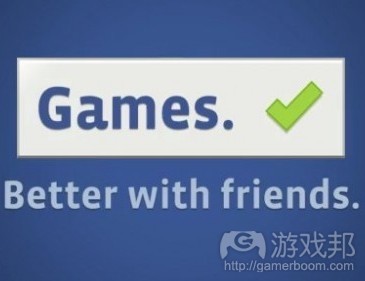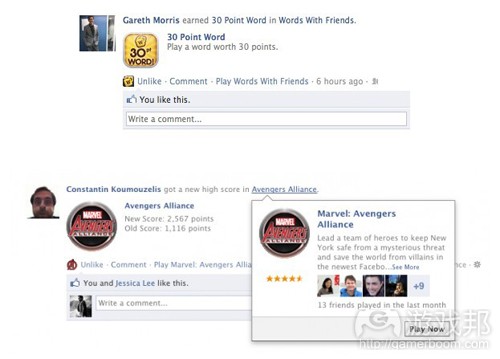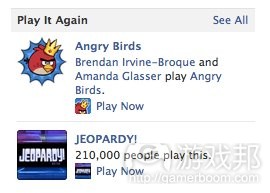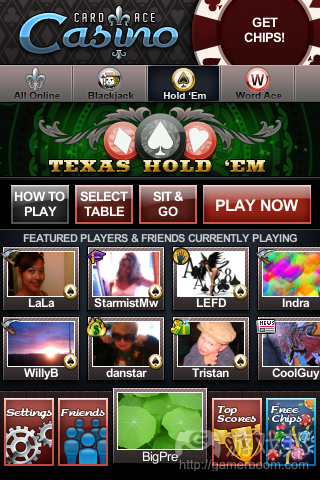每日观察:关注与社交游戏相悖的4项传统游戏设计原则(3.7)
1)Facebook近日通过博客宣布,未玩游戏的Facebook用户将可通过“achievement stories”、“high score stories”和“passing stories” 三种类型的News Feed消息看到好友在社交游戏中的分数和成就。该网站还将添加一个“重玩游戏”的新条目,鼓励用户重返之前已体验的游戏。
据Facebook所称,自从推出整合“玩游戏”消息的功能之后,新用户点击消息后的游戏安装率提升了60%。用户点击率最高的消息、Likes和评论将在News Feed和Timeline获得更多曝光率。
2)据venturebeat报道,前社交游戏网站Hi5(已被Tagged网站收购)总裁Alex St. John最近成立新社交游戏公司及网站Maqi.com,该公司位于加州,其宗旨是成为与Facebook相匹敌的社交游戏终点站。
St. John称Maqi.com是以“纯游戏网站”为起点,这一点不同于Hi5和Facebook的社交网站路线。他称Hi5的失策在于它采用实名制,这一点不利于人们体验社交游戏(例如,没有人会希望被老板发现自己在玩游戏)。Maqi.com保留了Hi5的社交游戏功能,并植入一个免费虚拟商品平台Mojo Market。Maqi.com的API支持开发商快速将Facebook游戏移植到这个新平台。
3)Big Fish Games日前收购加州手机社交游戏公司Self Aware Games(游戏邦注:代表作是博彩游戏《Card Ace:Casino》,有25名成员)及其母公司Social Concepts。
这是继虚拟博彩游戏公司IGT以5亿美元收购Double Down Interactive(代表作是《DoubleDown Casino》),Caesars Interactive收购Playtika(之后发布了《Caesars Casino》)后,又一项涉及博彩游戏领域的收购交易。
与其他Facebook同类游戏一样,《Card Ace:Casino》是一款针对iOS和Android的免费手机游戏,Self Aware还运营一个基于地理定位的手机MMO游戏平台以及iPad游戏《Fleck Touch》。
此外,Big Fish还宣布公司2011年收益同比上年增长30%,连续9年创下纪录。
4)Spry Fox首席创意官Daniel Cook在最近的GDC大会发言中指出,比起模仿他人作品并只发挥10%的创意,将自己的职业生涯用于创造新鲜有趣的内容更有意义。
他称有业内有80%游戏开发者为那些只知山寨他人作品的工作室效力,并强调了保持创新和领先的重要性。他认为成为创新者必须经历三个阶段:最初是扮演“学徒”角色,完成一些重复性的工作,第二个阶段是“熟练工”,要用不同方法将现存的想法整合起来,“熟练工”设计师很擅长执行,并总能在开发过程中提出一些新想法。最后一个阶段才是“创新大师”,他们需从许多截然不同的领域提取精华,将这些想法融为一体,使之成为全新的内容。
此外他还表示,自己很讨厌撰写设计文件,并认为这是一种浪费时间的做法。书面化的设计文件只是一些空洞理论,他更情愿使用设计笔记这种简便的方法。
5)Google+游戏及手机平台首席产品经理Punit Soni在GDC大会中指出,游戏是最有可能推动Google+创新和发展的内容,因此谷歌致力于与开发商建立良好关系以打造一个富有吸引力的社交平台。
他称今天的Google+已有1亿多MAU,以及5000万以上的DAU。游戏是Google+获得成功的关键,Google+游戏将在明年超越Chrome游戏、Native Client游戏或Android游戏的影响力。
6)Playdom创意总监、PopCap旧金山工作室创始人David Rohrl在GDC大会上发言表示,他认为优秀的游戏设计并非放之四海皆准,传统掌机游戏或硬核游戏设计并不一定适用于社交游戏。
他列举了4项不适用于社交游戏的传统游戏设计准则:第一个是设计师必须了解游戏的中“失败条件”(游戏邦注:这也是他在2005年休闲游戏大会上提出的建议)——例如在《赛尔达》被敌人袭击(一些休闲游戏也同样如此,如在《祖玛》中让彩球碰到青蛙的嘴),玩家在这些情况下就会输掉游戏。这种原则适用于硬核游戏玩家,因为他们追求的就是挑战,并且在开始游戏前就会做好失败的心理准备。
但《CityVille》等社交游戏基本上没有明显的“失败”条件。社交游戏玩家希望持续体验游戏,社交和Facebook游戏属于“超级休闲”类型,此类玩家希望自动取得胜利。
第二个原则是“持续增加复杂性以保持趣味性”。例如《魔兽世界》中的技能树,《英雄联盟》中的道具商店,它们都具有硬核玩家所需的复杂交互系统。甚至是《Peggle》这类休闲游戏也要求玩家从十个角色中挑选一者,每一者都有不同威力。而《CastleVille》等社交游戏却基本上没有复杂交互性,因为这类“超级休闲”游戏玩家希望能立即掌握游戏玩法。
第三个原则是向玩家展示获得最终胜利的途径(如何在游戏中获胜)。硬核游戏一般都会将玩家引向同一个地方:游戏结束(就算是赢家也需要结束游戏),而社交游戏关注的却是如何“让玩家长期逗留于游戏中”。
第四个原则是Chris Crawford在自己的游戏设计书中提到的理论——“关注玩家与游戏之间的交互性”。Rohrl称单人游戏的最精彩时刻是玩家“想出解决问题的方法”,而多人游戏则是玩家“展示了自己的技能”,社交游戏则是玩家“共同完成任务”。单人游戏促使玩家爱上游戏,而“超级休闲”游戏则让玩家“喜欢自己的朋友”。(本文为游戏邦/gamerboom.com编译,拒绝任何不保留版权的转载,如需转载请联系:游戏邦)
1)Facebook puts social game score stories in News Feed; module asks users to ‘play it again’
Brittany Darwell
Non-gaming Facebook users will now see their friends’ scores and achievements in social games through three new News Feed story types: achievement stories, high score stories and passing stories, the company announced in a blog post. Another unannounced item, “Play It Again,” encourages users to go back to games they’ve already tried.
The social network continues to experiment with ways to drive discovery and re-engagement for games as some developers begin to doubt the viability of the platform. Facebook says there has been a 60 percent increase in new users installing games by clicking on feed stories since launching an aggregate “playing” story. Now it hopes to drive additional traffic through scores and achievements posts. Examples of the three new story types are shown below.
Facebook says the stories that get the most clicks, Likes and comments will get more distribution in News Feed and on Timeline.
We’ve also seen the social network testing a module on the right sidebar that prompts users to return to games they’ve already installed. Facebook’s other efforts at re-engagement have been in the form of bookmarks and notifications.
We wrote last week that game discovery on Facebook is still no easy task, but we recognize the company’s creative attempts to solve the problem while protecting the user experience.(source:insidesocialgames)
2)Former Hi5 president Alex St. John reveals new social games network
by Mike Rose
Former Hi5 president Alex St. John reveals new social games network
Alex St. John, DirectX evangelist and formerly president of social gaming network Hi5 before it was acquired last year, has founded a new social gaming company and website.
“Social discovery” site Tagged purchased Hi5 a few months ago with the aim to dominate the social networking space through social games. However, it was an “asset-only” purchase, and did not include Hi5′s staff, including St. John.
Now St. John has revealed Magi.com, a new California-based company that is hoping to rival Facebook as the web’s one-stop social gaming destination, reports Venturebeat.
The new company has 30 employees, and is being financed by Hi5′s investors, Mohr Davidow Ventures and Crosslink Venture Partners.
St. John explained that being a “pure game site” from the very beginning, rather than beginning as solely a social network like Hi5 or Facebook, will be a huge benefit for the company.
“Hi5 was a real identity social network and that was holding us back,” he noted. “Do you want your boss to know you are playing social games all day?”
He said that, while Tagged has bought Hi5, Magi.com has retained the rights to the network’s social gaming features, including a free virtual goods platform called Mojo Market.
St. John also explained that Magi.com’s applications programming interfaces are based on Facebook’s own interfaces, and therefore adapting a Facebook game for Magi.com takes little effort for developers.
The social gaming network has already launched as an open beta, with developers such as DJ Arts, HitPoint Studios and Pixie Games providing early games.
Magi.com launches at an interesting time, as Zynga has only just launched its own social gaming network Zynga Platform. However, St.John said that he is not worried, as Zynga is “gummed up with Facebook.”
“It’s a coincidence that Zynga is becoming a publishing platform, but we are doing this with real and anonymous friends,” he argued.
“It does anonymous friend matching, but you can invite real friends and they can see who you are. It also does not sit behind a registration wall like Zynga has.” (source:gamasutra)
3)Big Fish buys mobile casino game maker
by Eric Caoili
Big Fish Games has acquired Self Aware Games (and its parent company Social Concepts), an Oakland, California-based mobile and social game developer best known for creating Card Ace: Casino.
The purchase follows a number of companies stepping into the social casino game space, like virtual gambling game firm IGT, which bought Double Down Interactive (DoubleDown Casino) for $500 million; and Caesars Interactive acquiring Playtika (Slotomania) and releasing Caesars Casino.
Zynga also has plans to form its own Zynga Casino franchise that will include its popular Zynga Poker/Texas HoldEm Poker game (33.2 million monthly active users, according to AppData). And just two weeks ago, EA PopCap launched its open beta for Lucky Gem Casino.
Unlike those Facebook titles, Self Aware’s Card Ace: Casino is a free-to-play mobile release available for iOS and Android devices. The company is also working on a location-based mobile MMO game platform, and an iPad title called Fleck Touch.
This acquisition adds 25 employees to the Seattle-headquartered Big Fish, and gives the casual game publisher access to Self Aware’s virtual goods technology platform. Big Fish intends to bring the studio’s mobile-social brands to the platforms where it traditionally distributes games, too.
Along with the purchase, Big Fish announced that it saw a 30 percent year-over-year increase in revenues for 2011 — its ninth consecutive year of record revenues. The publisher attributed the growth to digital sales for its 2500+ game catalog across PCs and smartphones. (source:gamasutra)
4)GDC 2012: How designers can increase innovation in their games
by Simon Parkin
Game designers have a choice: Spend your professional life trying to make something interesting and new, or spend it creating “shady, derivative crap.” This was the pointed message from Daniel Cook, Chief Creative Officer at Spry Fox (Triple Town), in a talk delivered at GDC this afternoon.
“There’s a lot more to life than than cloning the work of others and merely adding your own 10 percent innovation,” he said. “I want designers to stand up and say: ‘I am an inventor!’ That way we have a chance to not only make a mark upon the world, but even change it.”
Cook estimated that 80 percent of game developers work in studios which seek to copy the successes of other innovators. “But I believe the genres that exists today are the tip of an iceberg that is going to radically revolutionize this industry over the next few decades,” he said. “It is an exciting, exciting time. There is so much invention left to be done.”
Cook was eager to emphasize the business benefits of invention over re-purposers. “Innovation pays off as it allows you to be first, fastest and to dominate. You have to invent and execute, of course. If you fail to execute then it leaves the door open for someone to come in an take your innovation and establish their game around it as market leader. But there is a
magic spot where innovation tied with execution pays off in this industry.”
Cook described three phases of the journey towards becoming an inventor. “Game designers usually start off in the ‘Apprentice’ role, repeating complete patterns. This is valid as a student pursuit. But if you follow this into professional idea, then you become a hack. The second phase is ‘Journeyman’ where you’re taking ideas that already exits but mixing them in different ways. Journeymen designers are excellent at execution and usually introducing a few new ideas into the process.”
“Finally, the ‘Master Inventor’ is the final evolution, someone who takes ideas from many disparate places, melding them together into something wholly new and innovative.
Cook outlined a number of tools to aid developers in the quest for invention. “Designing from the root is an excellent way to promote invention,” he said. “Often, when we begin making a new game, we look to a breakout hit and we wonder how we can improve it. Instead of doing that, go backwards. Reduce the new hit to its absolute new fundamentals. Pick one thing that is amazing about it that you love and have that at the core of what you want to do.”
“As you retreat to the root that, begin listing anti-patterns,” he continued. “Find a list of things that you are not allowed to do. Existing genres offer easy solutions to existing problems. It’s so easy to fall back into those things, but if you deliberately work against them then you increase the chances you’ll innovate in a new way.”
Cook had strong words to say against design documents and milestone deliveries. “I hate design documents,” he said. “Anyone writing design documents right now: You are wasting your life.
Written designs are theories and they become locked in too early. Instead try to use design logs — more like a diary of the design. They look ahead at next few steps, but mainly chart reactions to the theories and builds.”
“Iterate with the willingness to change direction,” he said. “Milestones are the enemy of innovation. In real invention the goals change. Be open to changing goal posts as you go. That way we have more of a chance to claim that we are inventors.” (source:gamasutra)
5)GDC 2012: ‘Games are key to the success of Google+’
by Kris Graft
At GDC 2012 on Tuesday, Punit Soni, lead product manager for Google+ games and mobile, stressed that Google’s young social network relies on game developer partnerships for growth.
Google has been working to grow its Google+ social network as Facebook — a company whose name seemed to be actively avoided during the GDC session — continues to dominate the space.
It’s games that have the most potential for driving innovation and growth on Google+, Soni said, as games push the boundaries of technology and of social networking. So it was natural that Google would make games an integral part of Google+.
“We realized very early on that developers are key partners. … We need to learn from you guys and build a very compelling social platform,” Soni said.
He added that Google+ today is essentially Google 2.0, which is powered by a social layer. Today, Google+ has over 100 million monthly active users, and over 50 million daily active users — numbers too big for some game developers to ignore.
Soni said users spend over one hour a day on Google properties, and reported a 5-10 percent uplift on ads with social annotation.
Soni categorized Google+’s August 2011 closed launch with 16 games as “conservative,” as the company wanted experiment and learn how games will work on the network, and how partnerships with game developers would operate.
Several months on, the company is getting a grip on the needs of game developers. “Games are key to the success of Google+,” said Soni. “Next year we won’t be talking about Google+ games, Chrome games, games for Native Client or Android games — we’ll just be talking about Google games.” (source:gamasutra)
6)GDC 2012: Traditional advice that doesn’t apply to social games
by Ben Abraham
After 13 years in the core game development space, Playdom creative director and PopCap San Francisco founder David Rohrl’s transition to social games should have proven a relatively pain-free process. However, he spent the better part of a year in a state of frustration and anxiety. The heart of the problem was that, as he puts it, “Good game design is not completely universal. …there’s a lot that doesn’t cross over” from traditional console or core game design to social game design.
While important differences between, say, online multiplayer and AAA single player development are generally recognized, “some platforms are more different than others.” There is plenty of solid design advice from the core games space that will only lead to headaches in social games: “Social is an extreme outlier,” says Rohrl. When you shift across platforms, good design principles can become bad ones and old habits can cause problems.
Rohrl elaborated four pieces of common sense advice from traditional game design that simply do not apply to social games. The first rule to throw away is that designers need to “understand [their] game’s loss condition” — advice that Rohrl himself gave out in 2005 at a casual games conference.
Rorhl used a screenshot of Zelda as an example of this rule — understanding how to lose is extremely clear: get hurt by an enemy, lose your hearts. Even the casual game Zuma has a clear loss condition: if the colored balls reach the mouth of the frog, the player loses.
But this rule applies to hardcore gamers because they tend to seek out challenge and expect a loss condition to be part of their initial orientation to the game.
In CityVille and similar social games, there is no explicit “lose” condition. Social gamers expect uninterrupted forward progress — an expectation that is very difficult to disrupt. On the “Axis of Casualness,” social and Facebook games present a new “extreme” of casualness, the “hyper casual”.
At the more well known “core” end of the spectrum, players need to conquer failure. At the “hypercasual” end, social and Facebook game players expect automatic success.
Tongue firmly in his cheek, Rohrl noted that, “Casual gamers, contrary to popular perception, do like to make choices — to choose between the win button and the win big button.”
The second rule is to “keep adding complexity to keep things interesting.” Rohrl’s examples were the World of Warcraft talent tree, with a range of options that interact with multiple systems in complex ways, and the League of Legends item store — showing a similarly complex system of interactions, which core gamers have come to expect.
Even the casual game Peggle features a character select screen with ten characters, each with distinct powers. In contrast, there are no complex interactions the social game player needs to master in order to succeed at CastleVille. Expectations are different — hypercasual players want to use your game for different things than you might expect them to, and they want to understand things instantly.
The third rule of game design that fails to apply to social games is that designers have to show a clear path to final victory (or, how to win your game). It can also be expressed as “You always want to give the player a map”.
Game maps in core games and console games tend to lead to one place: Game Over (even if you win). This doesn’t work with social games. Social game designers need to ask themselves, “How long do we want the player to play our game?”
With more in common with MMOs that never finish development than console games that are designed to be played a small number of times — or even with multiplayer online games designed to be played numerous times — social games are constantly and continuously deployed. Console and downloadable games are “shipped” once, episodic games may be delivered a few times, and MMOs are paid for monthly, social games are often updated weekly, or even daily.
The fourth and final rule of game design that will only cause a social game designer create a “wretched” social game, is embodied by the advice Chris Crawford gave in his book on game design: “Focus on interactions between player and game.”
Rohrl compared the “great moments” in single player games, casual games and social games. In single player games, players are likely to say, “I figured it out”, multiplayer games, users say, “I demonstrated my skill.” Social games make players say, “We did something together.”
Single player games, according to Rohrl, “train players to love the game” whereas hypercasual games “train the player to love their friends.” (source:gamasutra)














































 闽公网安备35020302001549号
闽公网安备35020302001549号